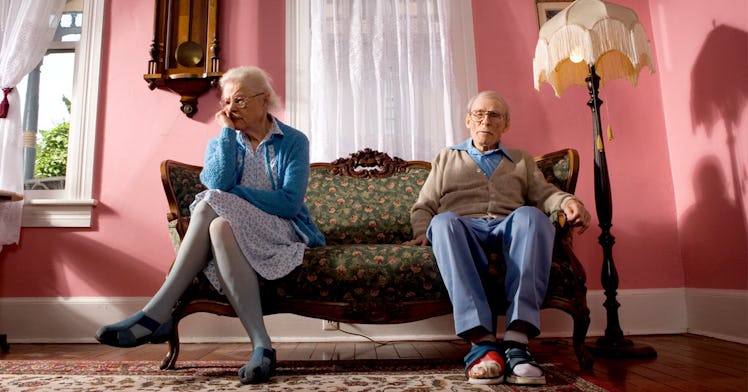When envisioning retirement, many people picture enjoying their golden years with their partner, reaping the benefits of a life well-lived together. However, an increasing number of older American adults are taking an unexpected turn for their age group—divorce. According to a 2021 report by the U.S. Census Bureau, a growing number of couples over the age of 65 are ending their marriages, often after decades together. This trend, known as “gray divorce,” is contributing significantly to the rise in single-person households in the U.S.
Gray divorce refers to the dissolution of a marriage that occurs after the age of 50, often following a long-term union. These individuals may have been married for many years but ultimately decide to part ways in their later years. But why is gray divorce becoming so prevalent? Unlike younger couples who might separate due to incompatible parenting styles or conflicts with in-laws, older divorcees often cite empty nest syndrome, infidelity, and financial disagreements as the main reasons. Instead of battling over child custody, these older couples are more likely to dispute pension plans and retirement savings. Divorce can be financially devastating, particularly for those closer to or already in retirement, as they have less time to recover financially.
The Increasing Prevalence of Gray Divorce
Gray divorce is becoming increasingly common, and the reasons are multifaceted. Statistics indicate that Baby Boomers are more prone to divorce, influenced by factors such as empty nest syndrome, shifting priorities, financial issues, and reduced societal stigma around divorce. Let’s delve deeper into why divorcing after age 50 is becoming more frequent and its potential impacts on personal well-being.
How Common Is Gray Divorce?
A 2022 study examining historical trends in gray divorce revealed that divorce rates among middle-aged and older adults have been rising since 1970. While gray divorce was relatively rare in 1970 and only grew modestly until 1990, the percentage of marriages ending in divorce for those over 50 jumped from 8.7% in 1990 to 36% in 2019. Additionally, individuals over 65 are the only age group with increasing divorce rates, whereas the divorce rates among younger adults in their 20s and 30s have actually declined in recent years.
Generational Influences
One explanation for the rising gray divorce rates is the generational tendencies of Baby Boomers—those born between 1946 and 1964. This generation has a higher propensity for divorce than both older and younger generations. Boomers were more likely to divorce during their younger years, and their divorce rates have continued to rise as they age.
Additional risk factors for gray divorce include the number of previous marriages and the duration of the current marriage. Remarriages are less likely to last, and marriages that have lasted nine years or less are more prone to divorce. Notably, many couples who divorce after age 50 have been married for decades. According to Pew Research Center statistics, 34% of gray divorces involve couples married for at least 30 years, and 12% involve couples married for 40 years or more.
Also Read :Innovative IOS App Revolutionizes Payday Loan Access Through Swipe Functionality
Factors Contributing to Gray Divorce
Why do couples opt to split after enduring many challenges together? The reasons are varied and complex, including:
Empty Nest Syndrome
The departure of children from the home can create a significant shift in a relationship, often leading to what is termed “empty nest syndrome.” Couples may find that, without their roles as parents to unify them, they have little in common. This lack of shared interests and connection can prompt individuals to seek fulfillment outside the relationship.
“For many couples, the children have been the source of their connection,” says Kimberley Best, RN, MA, a dispute resolution expert. “When the children are gone, some couples realize they have drifted apart and no longer share strong connections or common interests.”
Financial Issues
Arguments over money can intensify as couples approach retirement age. Financial infidelity—hiding bills, large purchases, debts, or secret bank accounts—can destabilize long-term marriages. When financial behaviors and goals are misaligned, it can jeopardize retirement plans, making divorce seem like the only resolution.
Infidelity
Cheating remains a prevalent reason for divorce across all ages, including older couples. Infidelity represents a profound betrayal, and after a lifetime of shared memories, the breach of trust can be irreparable.
Health Problems
Serious health issues can strain relationships, and some couples find themselves unable to cope with these challenges. Interestingly, research indicates a gender disparity in how health problems affect divorce risk. Women with chronic illnesses face a higher divorce risk, whereas men with similar conditions do not experience the same level of risk.
Growing Apart
One of the most significant causes of gray divorce is the changes people experience as they age. Growing apart is the most frequently cited reason for divorce at any age. For older adults, aging brings substantial changes, and their priorities, interests, and needs may evolve. While some couples grow closer, others may find their values and priorities diverging, leading to separation.
Changing Expectations
Expectations of marriage have evolved over time. Couples today are more likely to value how the relationship contributes to their overall happiness and fulfillment. When a relationship no longer meets these criteria, some may choose to end it, even after many years together.

Societal Changes
Societal shifts have also played a role in the rise of gray divorce. Older adults, raised with the expectation of lifelong marriage, now recognize that there are various paths to happiness. Women, in particular, have gained more freedom and financial independence.
“The majority of divorces are initiated by women, including gray divorces,” explains Kate Engler, LMFT, CST. “In the last 50 years, women’s economic independence has increased, offering more options, including the choice to divorce.”
With longer life expectancies, many people—especially women—look ahead and decide not to spend their remaining years in an unsatisfying marriage. Attitudes toward divorce have become more supportive among those over 50, and the reduced stigma around divorce encourages people to leave unhappy relationships.
Financial Considerations in Gray Divorce
Divorce can have severe financial consequences, particularly for older adults.
“Gray divorce can be financially devastating,” Best explains. “Often, people save for a joint retirement, which must be split in divorce, leaving less income for both parties.”
Key financial considerations for gray divorce include:
- Dividing Assets: Splitting financial resources, possessions, and property accumulated during the marriage can be contentious.
- Retirement Savings: Dividing retirement savings affects the financial security of both parties.
- Healthcare Costs: One spouse may lose access to health insurance benefits, which is a significant concern for older adults.
- Housing and Legal Expenses: The costs associated with divorce, including housing and legal fees, can add up quickly.
Emotional and Psychological Impact of Gray Divorce
Gray divorce also has profound emotional effects. Ending a long-term marriage can be a significant life change, particularly during elderhood, a time when many people seek stability.
Grief and Loss
Letting go of a shared connection and the dreams built together can evoke a deep sense of grief and loss, comparable to mourning the death of a loved one. Engler describes this as “ambiguous loss,” where the person is still alive but no longer present in one’s life.
Stress, Anxiety, and Depression
The mental health effects of gray divorce can vary. Some experience a sense of renewal, while others may struggle with stress, anxiety, or depression.
“When a lifetime partnership ends, people must readjust and rethink what brings them meaning, purpose, and connection,” explains Michelle Feng, MD.
Loss of Identity
Gray divorce can lead to a loss of identity, forcing individuals to redefine themselves outside of their marriage. This can impact self-esteem and self-worth, leading to feelings of inadequacy and rejection.
Loneliness and Isolation
Older adults are at a heightened risk of loneliness, which can be exacerbated by divorce. Changes in social networks and adjusting to single life can be overwhelming. Loneliness is linked to health problems like dementia and heart disease.
Health Effects
Marriage generally correlates with better health and longevity, but an unhappy marriage can be detrimental. Ending a toxic marriage can improve overall health and well-being.
Maintaining Health and Wellness During Gray Divorce
Despite the challenges, there are steps to maintain health and well-being during a gray divorce:
- Find Support: Engage with friends and family to mitigate loneliness.
- Give Yourself Time: Allow time to process complex emotions.
- Set Boundaries: Establish boundaries with your ex, children, and friends.
- Practice Self-Care: Maintain self-care routines.
- Talk to a Financial Counselor: Seek financial advice to adjust to new economic circumstances.
- Manage Stress: Utilize relaxation techniques to combat stress.
- Cultivate New Connections: Build new social networks and consider dating again.
Resources and Support for Gray Divorcees
Navigating gray divorce can be challenging, but numerous resources can provide support:
- Family and Friends: Trusted loved ones can offer practical and emotional support.
- Mental Health Professionals: Therapists can help process emotions and develop coping strategies.
- Financial Advisors: Financial planners can help manage post-divorce finances.
- Legal Experts: Divorce attorneys can clarify legal rights and obligations.
- Support Groups: Support groups provide community and validation.
- Online Resources: Online articles and forums offer valuable insights and advice.
Divorce signifies the end of a significant relationship, but with the right support and resources, gray divorcees can navigate this transition and find fulfillment in their later years.


One thought on “Older Couples Splitting Up: The Rise of Gray Divorce”